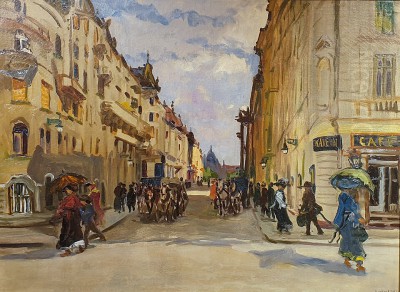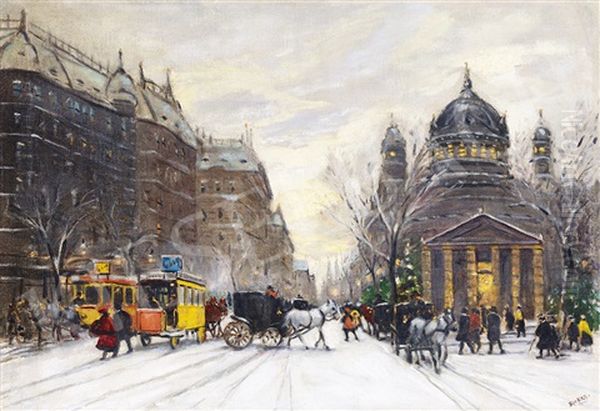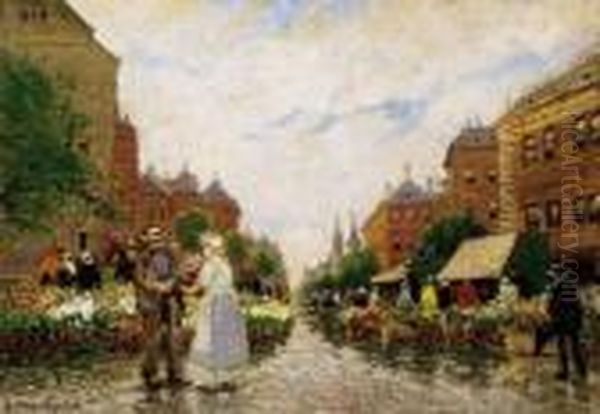
Antal Berkes stands as a significant figure in Hungarian art history, a painter whose canvases captured the fleeting moments and atmospheric nuances of urban and rural life at the turn of the 20th century. Born in Budapest in 1874 and passing away in 1938, Berkes developed a distinctive style influenced by Impressionism, dedicating much of his career to depicting the bustling streets of Budapest and Vienna, as well as serene landscapes. His work offers a valuable window into the Austro-Hungarian Empire's final decades and the early years of independent Hungary.
Early Life and Artistic Formation
Antal Berkes began his artistic journey in his native Budapest, a city undergoing rapid transformation and modernization. He enrolled in the Hungarian Academy of Fine Arts (Magyar Képzőművészeti Egyetem), a crucial institution that nurtured many talents who would define Hungarian art. During his studies, he likely absorbed the academic traditions prevalent at the time but also became exposed to newer, more progressive European art movements filtering into Hungary. Figures like Károly Lotz and Bertalan Székely were influential professors associated with the Academy around this period, emphasizing historical and mural painting, but the winds of change, particularly from Paris, were beginning to blow.
Initially, Berkes focused primarily on landscape painting. His early works often depicted the Hungarian countryside, showcasing an appreciation for nature and a developing sensitivity to light and atmosphere. This grounding in landscape provided a strong foundation for his later, more famous urban scenes. His training equipped him with solid technical skills in oil painting, which he would adapt to suit his evolving Impressionistic style.
The Allure of the Cityscape
A pivotal shift occurred in Berkes's career as he turned his attention towards the urban environment. While he continued to paint landscapes throughout his life, his reputation became increasingly tied to his cityscapes. He was particularly drawn to the dynamic energy and visual richness of Budapest and Vienna, the twin capitals of the Austro-Hungarian Empire. These cities, with their grand boulevards, bustling squares, horse-drawn carriages (fiacres), omnibuses, and eventually, early automobiles, provided endless inspiration.

His move towards urban subjects coincided with a broader European artistic interest in depicting modern life. Artists like the French Impressionists had already paved the way, showing that contemporary city life was a valid and exciting subject for art. Berkes embraced this, finding beauty in the everyday scenes of the metropolis – rainy streets reflecting gaslight, snow-covered squares teeming with pedestrians, the architectural interplay of buildings under changing skies.
Influence of Impressionism
Antal Berkes is primarily categorized as an Impressionist painter, and the influence of this French movement is evident in his work. He adopted key Impressionist concerns, particularly the focus on capturing the transient effects of light and atmosphere. His brushwork became looser and more visible compared to strict academic styles, allowing him to convey the immediacy of a moment. He paid close attention to colour, often using a palette that emphasized mood, whether the cool greys and blues of a winter day or the warmer tones of late afternoon sun.
While clearly influenced by French masters like Claude Monet and Camille Pissarro, known for their revolutionary approaches to light and landscape, Berkes developed his own distinct interpretation. His cityscapes often possess a slightly melancholic or romantic atmosphere, perhaps reflecting a Central European sensibility. Unlike the sometimes stark objectivity of some French Impressionists, Berkes imbued his scenes with a palpable mood. His handling of wet pavements, misty air, and the soft glow of artificial light became hallmarks of his style. He explored variations in light, reportedly going through periods described as "dark" and "light" phases in his career, suggesting conscious experimentation with tonal values and luminosity.
Parisian Sojourn
Like many ambitious artists of his time, Berkes spent a period living and working in Paris. This experience undoubtedly deepened his engagement with Impressionism and Post-Impressionism. Paris was the undisputed centre of the art world, and exposure to its galleries, salons, and the works of leading French artists would have been immensely stimulating. While specific details of his interactions or collaborations in Paris are scarce, the time spent there clearly refined his focus on urban themes.
He absorbed the Parisian way of seeing the city – as a place of constant movement, social interaction, and atmospheric beauty. The influence of artists like Alfred Sisley, with his delicate renderings of the Île-de-France region, or even Gustave Caillebotte, with his structured depictions of Parisian boulevards, might be subtly discerned in Berkes's approach to composition and perspective in his city views. His Parisian experience likely reinforced his commitment to capturing the essence of modern urban existence.
Key Themes and Subjects

Berkes's oeuvre revolves around several recurring themes. Budapest remained his most frequent subject. He painted iconic locations like Kálvin Square, Andrássy Avenue, and views along the Danube, but often focused less on precise topographical accuracy and more on the overall feeling of the place. He was fascinated by weather conditions and times of day, frequently depicting scenes in winter, rain, or at dusk, when light conditions were most dramatic and evocative.
Vienna also featured prominently in his work, offering a slightly different but equally grand urban spectacle. His paintings often include figures – pedestrians huddled against the cold, passengers boarding trams, drivers guiding their fiacres – which animate the scenes and add a human dimension. These figures are typically rendered impressionistically, integrated into the overall atmosphere rather than being detailed portraits. The inclusion of vehicles, from horse-drawn carriages and omnibuses to early automobiles as seen in Automólis a Kálvin Square (Car on Kálvin Square), documents the technological transitions of the era.
Beyond the city, Berkes continued to paint rural landscapes, often depicting tranquil scenes of the Hungarian countryside, villages, or waterside settings, as exemplified by works like Home in the Countryside and Au bord l'eau (Walk by the Water). These works provide a contrast to his urban views, showcasing his versatility and enduring connection to nature.
Notable Works
Several paintings stand out as representative of Antal Berkes's style and thematic concerns:
Automólis a Kálvin Square: This significant work captures the intrusion of modernity into the historic cityscape, featuring an early automobile amidst the more traditional traffic of Kálvin Square in Budapest. It highlights Berkes's engagement with contemporary life and has achieved high valuations at auction, indicating its importance.
Budapest in Winter with Fiacre: A quintessential Berkes theme, this type of painting showcases his mastery of depicting winter scenes. He excelled at rendering snow-covered streets, the soft grey light of a winter sky, and the solitary figures or vehicles that punctuate the quiet landscape. The fiacre, a recurring motif, adds a touch of nostalgia.
Nagyvárosi sétányon omnibuszok, 1914 (Omnibuses on a Metropolitan Promenade, 1914): This title points directly to his interest in urban transport and the flow of life on major city thoroughfares. Such works capture the energy and scale of the modern metropolis.
Home in the Countryside: Representing his landscape work, this painting likely evokes a sense of peace and traditional rural life, contrasting with the dynamism of his cityscapes. It demonstrates his ability to handle natural light and pastoral themes with sensitivity.
Au bord l'eau (Vizpáti séta) (Walk by the Water): This work, likely depicting a scene along a river or lake, showcases his skill in rendering water and reflections, a common challenge and interest for Impressionist painters.
These examples illustrate the range of his subjects and his consistent focus on atmospheric effects, whether in the heart of the city or the quiet of the countryside.
Commercial Success and Artistic Production
Antal Berkes achieved considerable popularity during his lifetime. His evocative cityscapes resonated with the public and collectors, leading to a high demand for his work. This popularity, however, brought its own challenges. To meet the demand from art dealers and the market, Berkes reportedly began to produce variations of his most successful themes and compositions, sometimes leading to accusations of repetition or "mass production."
While this practice might raise questions about artistic originality for some critics, it was not uncommon for popular artists of the era to revisit successful subjects. It also speaks to the widespread appeal of his particular vision of the city. His ability to consistently capture the desired mood and atmosphere meant his works remained sought after. His paintings frequently appeared in galleries and auctions, such as those held by Kieselbach Gallery, a prominent venue for Hungarian art, confirming his established presence in the art market.
Exhibitions and Recognition
Berkes's work was recognized through various exhibitions. He notably exhibited at the Ottó Herman Museum in Miskolc, Hungary (though sometimes associated with Budapest exhibitions). His participation in shows like "Paris through Hungarian Eyes" is significant. This exhibition reportedly placed his work alongside that of other Hungarian artists connected to Paris, potentially including giants like Mihály Munkácsy (though Munkácsy belonged to an earlier generation and different style, his fame was immense) and contemporaries like Ernő Lederer. Such exhibitions helped contextualize his work within the broader narrative of Hungarian artists engaging with international trends.
His inclusion in auction catalogues and museum collections further solidified his reputation. While perhaps not as revolutionary as some of the leading French Impressionists or Hungarian avant-garde figures who followed, Berkes carved out a distinct and respected niche for himself. His work was also featured in contexts beyond traditional galleries, potentially including cultural events or festivals that incorporated visual arts, suggesting a broader cultural presence.
Context within Hungarian Art
Antal Berkes occupies an important place within the landscape of Hungarian art at the turn of the century. He was part of a generation exploring Impressionism and Post-Impressionism, adapting these international styles to Hungarian subjects and sensibilities. He can be seen alongside other notable Hungarian painters of the era who engaged with similar influences.
Pál Szinyei Merse is considered a key pioneer of Hungarian Impressionism, working even earlier than Berkes. The artists associated with the Nagybánya artists' colony, founded in 1896, such as Károly Ferenczy, István Réti, and János Thorma, were crucial contemporaries who championed plein air painting and modern approaches, though often with a greater focus on rural Transylvanian landscapes and figurative compositions. József Rippl-Rónai, another major figure, brought influences from the French Nabis group back to Hungary.
Compared to the often sun-drenched, brightly coloured works of the Nagybánya school, Berkes's cityscapes frequently explore a more subdued, atmospheric palette, focusing on urban moods. He shares a sensitivity to atmosphere with László Mednyánszky, a unique figure known for his haunting landscapes and depictions of the poor, though Mednyánszky's style is darker and more expressionistic. Berkes's dedication to the cityscape as a primary subject also distinguishes him within the Hungarian context of the time. Other contemporaries like István Csók explored various styles including Impressionism and decorative compositions.
European Context and Influences
Berkes's work should also be understood within the wider European context. His time in Paris placed him at the heart of artistic innovation. The French Impressionists' legacy was profound, and their focus on modern life, subjective perception, and the effects of light provided a crucial framework for artists across Europe. Berkes adopted these principles but filtered them through his own perspective.
While direct comparisons can be limiting, his interest in capturing the ephemeral qualities of light and weather aligns him with Monet and Pissarro. His structured city views might distantly echo Caillebotte or even the earlier flâneur-perspective paintings of Édouard Manet, who depicted the social life of Paris. However, Berkes generally maintained a softer, more romanticized vision compared to the sometimes analytical or socially critical edge found in some French works. He remained largely committed to a visually pleasing, atmospheric Impressionism throughout his career.
Legacy and Evaluation
Antal Berkes left behind a substantial body of work that continues to be appreciated, particularly in Hungary. His paintings are valued for their technical skill, their evocative portrayal of Budapest and Vienna during a specific historical period, and their accessible Impressionist charm. He successfully captured the unique atmosphere of these Central European capitals – the blend of grandeur and intimacy, the effects of weather and light on the urban fabric.
While he may not be considered a radical innovator in the vein of the major avant-garde movements, his contribution lies in his consistent and sensitive application of Impressionist techniques to his chosen subjects. He provided a romantic yet recognizable vision of city life that resonated with his contemporaries and continues to appeal to viewers today. His works are frequently featured in Hungarian art auctions and collections, confirming his enduring status as a beloved painter of Budapest's streets and Hungary's landscapes. He remains a key representative of Hungarian Impressionism, known for his atmospheric cityscapes that capture the soul of a bygone era.
Conclusion
Antal Berkes was a dedicated and skilled painter who found his voice in the depiction of urban environments, particularly his native Budapest. Influenced by Impressionism yet developing a personal style characterized by atmospheric sensitivity, he captured the essence of city life – its movement, its changing moods, its blend of nature and architecture – with remarkable consistency. His numerous views of Budapest and Vienna, alongside his tranquil landscapes, secure his position as an important figure in early 20th-century Hungarian art, a chronicler of the visual poetry of the everyday.